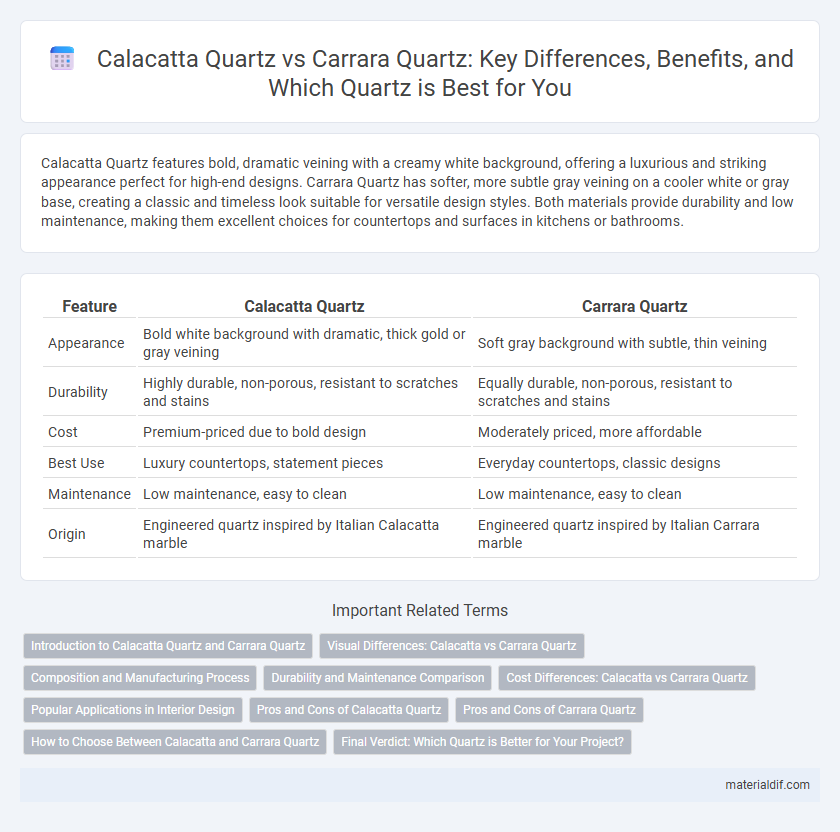Calacatta Quartz features bold, dramatic veining with a creamy white background, offering a luxurious and striking appearance perfect for high-end designs. Carrara Quartz has softer, more subtle gray veining on a cooler white or gray base, creating a classic and timeless look suitable for versatile design styles. Both materials provide durability and low maintenance, making them excellent choices for countertops and surfaces in kitchens or bathrooms.
Table of Comparison
| Feature | Calacatta Quartz | Carrara Quartz |
|---|---|---|
| Appearance | Bold white background with dramatic, thick gold or gray veining | Soft gray background with subtle, thin veining |
| Durability | Highly durable, non-porous, resistant to scratches and stains | Equally durable, non-porous, resistant to scratches and stains |
| Cost | Premium-priced due to bold design | Moderately priced, more affordable |
| Best Use | Luxury countertops, statement pieces | Everyday countertops, classic designs |
| Maintenance | Low maintenance, easy to clean | Low maintenance, easy to clean |
| Origin | Engineered quartz inspired by Italian Calacatta marble | Engineered quartz inspired by Italian Carrara marble |
Introduction to Calacatta Quartz and Carrara Quartz
Calacatta Quartz features bold, dramatic veining with a white to creamy background, prized for its luxurious and striking appearance in countertops and backsplashes. Carrara Quartz offers softer, more subtle gray veining against a light gray or white base, creating a classic and timeless aesthetic ideal for various interior styles. Both varieties provide durable, low-maintenance alternatives to natural marble, combining beauty with the practicality of engineered quartz surfaces.
Visual Differences: Calacatta vs Carrara Quartz
Calacatta Quartz features bold, dramatic veining with a high contrast between the bright white background and dark, thick veining, creating a luxurious and striking appearance. Carrara Quartz presents softer, more subtle gray veining on a cooler white or grayish background, offering a delicate, classic look. These distinct visual differences make Calacatta ideal for statement pieces, while Carrara suits minimalist or traditional designs.
Composition and Manufacturing Process
Calacatta quartz features a composition that mimics its natural marble counterpart with a high percentage of natural quartz combined with resins and pigments to produce distinctive bold veining patterns. Carrara quartz is engineered using a blend of finely ground quartz crystals, resin binders, and white pigments to replicate the soft, gray veining typical of Carrara marble. Both types undergo a sophisticated manufacturing process involving mixing, molding, curing, and polishing to achieve durable, non-porous surfaces ideal for countertops and tiles.
Durability and Maintenance Comparison
Calacatta Quartz offers superior durability compared to Carrara Quartz due to its denser composition, making it more resistant to scratches and chips in high-traffic areas. Both surfaces are non-porous, ensuring stain resistance and minimal maintenance, but Calacatta Quartz typically requires less frequent sealing. Maintenance for Carrara Quartz involves routine cleaning with mild soap and water, while Calacatta Quartz's robust structure allows for easier longevity with less upkeep.
Cost Differences: Calacatta vs Carrara Quartz
Calacatta quartz typically costs 15-25% more than Carrara quartz due to its rarer, more dramatic veining and luxurious appearance. Carrara quartz offers a more affordable option, often priced between $50 to $70 per square foot, while Calacatta quartz ranges from $70 to $95 per square foot. Installation and availability also influence the final cost difference between these two popular quartz surfaces.
Popular Applications in Interior Design
Calacatta Quartz is favored for luxury kitchens and high-end bathroom countertops due to its striking bold veining and bright white background, enhancing modern and classic interior designs. Carrara Quartz, with its softer, subtle veining and neutral tones, is commonly used in backsplashes, vanity tops, and fireplace surrounds, offering versatile elegance for minimalist and transitional spaces. Both materials provide durable, low-maintenance alternatives to natural marble, widely chosen in residential and commercial interior design projects.
Pros and Cons of Calacatta Quartz
Calacatta quartz offers a luxurious aesthetic with bold, dramatic veining and a bright white background, making it a preferred choice for high-end kitchen countertops. It is highly durable, non-porous, and resistant to stains and scratches, which simplifies maintenance compared to natural marble like Carrara quartz. However, Calacatta quartz tends to be more expensive and may have less subtle veining, which may not suit all design preferences or budgets.
Pros and Cons of Carrara Quartz
Carrara Quartz offers a classic marble look with subtle gray veining on a white background, making it a popular choice for elegant kitchen and bathroom surfaces. Pros include high durability, low maintenance, and resistance to stains and scratches, ideal for busy households. Cons involve a higher price point compared to other quartz options and less dramatic veining than Calacatta Quartz, which may not appeal to those seeking a bolder aesthetic.
How to Choose Between Calacatta and Carrara Quartz
Choosing between Calacatta quartz and Carrara quartz depends on design preference and budget considerations; Calacatta quartz features bold, dramatic veining with a creamy white background, making it ideal for luxury spaces, while Carrara quartz offers softer, more subtle gray veining on a white base, suited for classic, understated looks. Both materials provide durability, low maintenance, and resistance to stains and scratches, but Calacatta quartz typically commands a higher price point due to its rarity and distinct aesthetic. Evaluate the desired visual impact and financial investment to select the quartz surface that best complements your interior style and practical needs.
Final Verdict: Which Quartz is Better for Your Project?
Calacatta Quartz features bold, dramatic veining and a bright white background, making it ideal for luxurious, statement-making spaces, while Carrara Quartz offers softer, more subtle veining on a cooler gray base, suited for classic and versatile designs. Calacatta Quartz tends to have a higher price point and a more eye-catching pattern, perfect for high-end projects that require standout aesthetics. Carrara Quartz provides a cost-effective, timeless look with easier integration into various styles, making it better for budget-conscious or understated designs.
Calacatta Quartz vs Carrara Quartz Infographic

 materialdif.com
materialdif.com